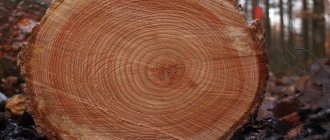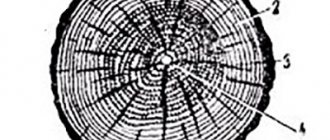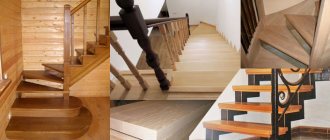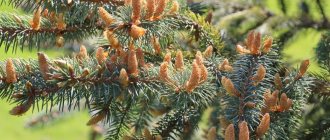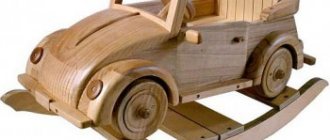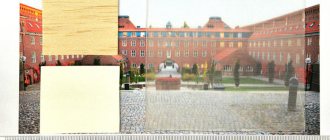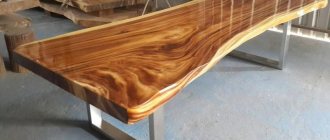Wood, wood - anisotropic fibrous material for construction, obtained from trees.
The main structural unit of wood of any species is fiber. Fiber in the initial stage of development has a shell that is quite elastic and easily permeable to water and aqueous solutions. With age, the strength of the shell increases sharply, and permeability decreases due to its transformation into high-molecular organic compounds: cellulose, hemicellulose and lignin. There are mechanical cells (libroform fibers), leading cells (vessels and tracheids), storage cells (parenchyma).
wood formation
Wood is one of the components of the vascular-fibrous bundle and is usually contrasted with another component of the bundle, originating from the same procambium or cambium - phloem or phloem. During the formation of vascular-fibrous bundles from the procambium, 2 cases are observed: either all procambial cells are transformed into elements of wood and bast - so-called closed bundles are obtained (higher spore, monocotyledonous and some dicotyledonous plants), or a layer of active material remains at the border between wood and bast tissues - cambium and open bunches emerge (cereals and gymnosperms).
In the first case, the amount of wood remains constant, and the plant is not able to increase its thickness; in the second, thanks to the activity of the cambium, the amount of wood increases every year, and the plant trunk gradually thickens. In Ukrainian tree species, the wood lies closer to the center (axis) of the tree, and the bast lies closer to the periphery. In some other plants, a different mutual arrangement of wood and bast is observed.
The composition of wood includes already dead cellular elements with woody, mostly thick shells; bast, on the contrary, is composed of living elements, living protoplasm, cell sap and a thin neo-woody shell. Although in bast there are dead elements, thick-walled and lignified, and in wood, on the contrary, there are living elements, but this does not significantly change the general rule. Both parts of the vascular-fibrous bundle also differ from each other in their physiological function: the so-called raw sap, that is, water with substances dissolved in it, rises up through the wood from the soil to the leaves, while plastic sap is formed down through the bast. The phenomenon of lignification of cell membranes is caused by the impregnation of the cellulose membrane with special substances, usually combined under the general name lignin.
The presence of lignin and, at the same time, lignification of the shell are easily recognized by certain properties. Thanks to wood, plant shells become stronger, harder and more elastic; At the same time, despite being easily permeable to water, they lose their ability to absorb water and swell.
There are primary wood, formed by procambium cells, and secondary wood, resulting from the activity of the cambium. On a cross section of the trunk of trees and shrubs, annual rings are clearly visible, which are formed as a result of periodic activity of the cambium throughout the year. In many trees, especially in southern latitudes, in the wood, in addition to the light outer part - the sapwood, there is also an inner, dark part (the core of the wood), in the cells of which resins, tannins, oils, gums, aromatic and dyeing substances, etc. are deposited.
Through the efforts of genetic engineering and breeders, significant progress has been achieved in the technology of accelerated cultivation of wood for energy and raw materials purposes: the average productivity of pine in Brazil as of 2006 is 28.5 m3 per hectare per year, eucalyptus - 119 m3. For comparison: the intensity of wood growth in Russian forests ranges from 1.5 m 3 per hectare per year for coniferous trees and up to 2.5-3.0 m 3 for deciduous trees.
Tree structure
Regardless of the species, the growing tree has:
• roots
• trunk
• crown
Regardless of the species, every tree has roots, a trunk and a crown
Roots
Roots serve not only to strengthen the tree in the soil and keep it upright, but most importantly, to feed the tree from the soil with water and nutrients necessary for its life and growth.
Trunk
The trunk is the most valuable part of the tree. This is its main part, since the volume of the trunk is from 50 to 90% of the total volume of the tree. In a growing tree, the trunk performs several functions:
— conducts water and nutrients from the roots to the crown and back;
- preserves the supply of these substances;
- serves as a support for the crown.
Near the ground, the tree usually has the largest trunk diameter (thickness), gradually and evenly decreasing upward. In a living, growing tree, a new cone-shaped layer of wood appears every year. Each next layer is higher and has a larger diameter.
The shape and type of trunk depend both on the type of tree and on its habitat. A pine tree growing in the forest has a straight, high trunk and a small crown. The same pine tree, but growing in an open place - a low, uneven trunk and a lush crown.
Crown
The crown of a tree consists of branches bearing foliage or needles. Leaves and needles absorb chemicals needed by the tree from the surrounding air. It is in the needles and leaves that, under the influence of sunlight, the carbon dioxide contained in the air is decomposed into carbon and oxygen.
The carbon is then combined with substances taken up through the roots from the soil and used to grow and nourish the tree. Oxygen is released into the air. Excess moisture entering the tree from the roots also evaporates through the leaves and needles.
chemical composition
Wood contains a number of complex organic compounds. Full chemical analysis shows that it contains about 50% carbon, 6% hydrogen and 44% oxygen. The cell wall has a network structure of interconnected chain cellulose molecules, filled with other hydrocarbons (hemicelluloses), as well as lignin and various extractives. The cementing intercellular substance is mainly pectates of calcium and magnesium, and resins, gums, fats, tannins, pigments and minerals accumulate in the cellular cavities, especially in deciduous wood. The composition of wood includes 45-60% cellulose, 15-35% lignin and 15-25% hemicelluloses. The amount of foreign, extractive substances largely depends on the species and is not the same in the sapwood and heartwood. The mineral content (ash content) of wood is usually significantly less than 1%.
Wood contains 5-25% extractives.
Technology improvements.
Thanks to new technological developments, wood has become more widely used in traditional areas and has found new applications. Such advances include improvements in drying technology, anti-rot and fire-retardant treatments, layered structures, prefabricated structures, and high-performance wood adhesives. Great strides have been made in the pulp and paper industry, as well as in the production of chemically processed wood-based materials such as synthetic fiber, cellophane, alcohol, yeast, fiberboard, polymer-impregnated wood, wood laminates and various molded products. Progress in the processing and use of wood has stimulated further development of forestry.
properties of wood
For wood, the main and most important properties are these.
- Mechanical and technological: strength, hardness, deformability, specific viscosity, operational characteristics, technological characteristics, wear resistance, ability to hold fasteners, flexibility;
- Physical: appearance (texture, shine, color), humidity (shrinkage, warping, water absorption, hygroscopicity, density), thermal (thermal conductivity, heat capacity), sound (acoustic resistance, sound conductivity), electrical (dielectric properties, electrical conductivity, electrical strength) ;
- Chemical properties.
Mechanical and technological properties
- Wood strength is the ability to resist destruction under mechanical loads. A distinction is made between compressive and tensile strength (in the directions of load application relative to the fibers - longitudinal and transverse) and static bending. The tensile strength of wood along the grain is 2 ... 3 times higher than the compressive strength and 20 ... 30 times higher than the tensile strength across the grain. For certain rocks, the tensile strength reaches 100 ... 200 MPa. The specific tensile strength of wood along the grain is comparable to that of steel and fiberglass. However, it is difficult to realize these properties of wood in structures due to the presence of shortcomings (knots, cracks, etc.) that reduce its strength properties. The tensile strength of coniferous wood depends little on humidity; for deciduous wood this influence is significant.
- The compressive strength of wood is determined on samples - prisms with a cross-section of 20 × 20 mm and a length of 30 mm along and across the grain. The compressive strength of wood along the grain is 4...6 times greater than its strength across the grain.
- The static bending strength of wood exceeds the compressive strength along the fibers, but the tensile strength is lower and amounts to 50 ... 100 MPa for different species. High values of static bending strength make it possible to widely use wood in structures subject to bending (beams, rafters, bars, decking, etc.).
physical properties
Relation to moisture
- Humidity is determined in the same way as any other material - it is the amount of water per unit volume or mass. Humidity is calculated as follows: the mass of a sample of wet material is measured, then the measured sample is dried in a dryer at a temperature of 100-105 ° C, then the weighing of the dry material occurs again. The difference between the mass of wet and dry material determines the amount of water contained in the sample. In order to calculate the mass humidity, you need to use a simple mathematical formula: the mass of the sample before drying minus the mass of the sample after drying, divide the result of the difference by the mass of the sample after drying and multiply by 100 percent. The result is the moisture content (mass) of the wood as a percentage.
- The hygroscopicity of wood is the ability of the material to absorb moisture from the environment. This property depends on the moisture content of the wood. Dry wood is more hygroscopic than moisture. To reduce hygroscopicity, the material is coated with oil paints, enamels or various varnishes. Hygroscopicity directly depends on another property of wood - porosity. Swelling of wood occurs when materials are exposed to high air humidity for a long time.
- Wood porosity is the ratio of pore volume to total wood volume. For different types of wood, porosity has different values, but on average its value ranges from 30-80%.
- Shrinkage is a change in size due to loss of moisture from wood as a result of drying. Shrinkage occurs naturally. A direct consequence of shrinkage is the formation of cracks.
- Warping occurs as a result of uneven drying of wood. Drying of wood occurs faster in layers more distant from the core, therefore, if drying was carried out in violation of the technology, the shape of the wood changes - it warps. Warping under the influence of shrinkage is different in different directions. Along the fibers it is insignificant and amounts to approximately 0.1%. Dimensional changes across the fibers are more significant and can represent 5-8% of the original. In addition, warping is often accompanied by the appearance of cracks in the wood, which significantly affects the quality of the final product. Warping and cracking can be avoided by following drying technology and using certain technologies when composing products. For example, longitudinal unloading cuts are made in logs along the entire length of the material, which relieve internal stresses formed during drying.
- Cracking is the result of uneven drying of the outer and inner layers of wood. The process of moisture evaporation continues until the moisture content in the wood reaches a certain limit (equilibrium), which depends directly on the temperature and humidity of the surrounding air.
thermal characteristics
- Thermal conductivity. Unlike other building materials, wood is a poor conductor of heat. This allows it to be used for thermal insulation of premises. The thermal conductivity of dry birch and pine wood along the grain is 0.128 and 0.349 W/(m K), respectively.
- The specific heat capacity is approximately the same for all wood species - for dry wood 1.7 ... 1.9 kJ / (kg K) at 0 ... 100 ° C.
Electrical properties of wood
The electrical properties of wood are determined by three indicators:
- Electrical conductivity (specific conductivity) - the reciprocal value of specific resistance, depends on humidity, wood type, temperature and direction of current flow. Specific resistance must be taken into account when harvesting wood for communication poles and power lines, when applying paint and varnish coatings in an electric field, and when measuring wood moisture content. The electrical conductivity of dry wood is insignificant, so it can be used as an insulating material. The electrical resistance of wood along the grain is several times less than across the grain. An increase in wood temperature leads to a decrease in its resistance by almost 2 times.
- Electric strength is an indicator that is characterized by the ratio of the electrical voltage at which breakdown of the material occurs with the thickness of the material. Electrical strength must be taken into account when assessing the electrical insulating properties of wood.
- Dielectric (insulating) properties. Such properties of wood are of practical importance when calculating the heating processes of a material in a field of high-frequency currents during drying, gluing and bending of wood. They are evaluated by two indicators: dielectric constant - the ratio of the capacitance of a capacitor with a wood gasket to the capacitance of the same capacitor with an air gap.
- dielectric loss tangent - the angle between two current vectors, one of which leads the voltage vector by an angle of 90 °, if there are no losses, the second leads the voltage vector by an angle less than 90 ° due to dielectric losses in the wood.
other properties
- Sound permeability is the ability of a material to conduct sound waves. If in the case of thermal conductivity wood is the best material, then in the case of sound permeability wood loses to other building materials. In this regard, when constructing walls and wooden floors, it is necessary to use additional materials (backfills) that reduce the sound permeability rate.
- Color is a kind of indicator showing the quality, age and condition of wood. High-quality and healthy wood has a uniform color without stains or other inclusions. If there are inclusions and stains in the wood, this is evidence of its decay. The color of wood may change due to atmospheric conditions.
- The smell depends on the content of resins and tannins in the wood. Freshly cut wood has a strong odor, and as the tree dries and the moisture and essential resins evaporate, the odor weakens.
- Texture is the pattern created when wood is sprayed. The cutting plane intersects annual rings and layers of wood formed at different times, resulting in a characteristic pattern of annual lines, which distinguish wood from other materials.
- Mass indicators of wood. There is a distinction between density and volumetric mass of wood. Density is the mass per unit volume of wood without taking into account voids and moisture. This mass does not depend on the type of wood and is 1.54 g / cm³. Bulk density is the mass per unit volume of wood in its natural state, taking into account moisture and cavities.
- Curling is a non-parallel arrangement of wood fibers along the longitudinal axis of a log, beam or board. It can be natural or artificial due to improper spraying. The oblique layer also greatly reduces the tensile strength of wood and, as a result, bending strength, that is, it is undesirable to use such boards or beams as beams, rafters, or tie rods. There are no other methods of control other than culling (or proper spraying). An example of over-curling is Karelian birch wood.
Chemical properties
The main organic substances that make up wood are cellulose, lignin and hemicelluloses.
Cellulose is a natural polymer, a polysaccharide with a long chain molecule. The formula of cellulose is (C 6 H10O 5) n, where n is the degree of polymerization equal to 6000-14000. This is a very stable substance, insoluble in water and ordinary organic solvents (alcohol, ether, etc.), white in color. Bundles of cellulose macromolecules in the form of thin fibers are called microfibrils. They form the cellulose framework of the cell wall. Microfibrils are usually oriented along the long axis of the cell; between them there is lignin, hemocellulose, and water.
Lignin is an aromatic polymer (polyphenol) with a complex structure; contains more carbon and less oxygen than cellulose. It is with this substance that the process of lignification of the young cell wall is associated. Lignin is chemically unstable, easily oxidized, interacts with chlorine, and dissolves when heated in meadows, aqueous solutions of sulfurous acid and its acid salts.
Hemicelluloses are a group of polysaccharides that includes pentosans (C 5 H 4) n and hexosans (C 6 H10O 5) n. At first glance, the hexosane formula is identical to the cellulose formula. However, the degree of polymerization in all hemicelluloses is much less and amounts to 60-200. This indicates shorter chains of molecules and less stability of these substances compared to cellulose.
4) n and hexosans (C 6 H10O 5) n. At first glance, the hexosane formula is identical to the cellulose formula. However, the degree of polymerization in all hemicelluloses is much less and amounts to 60-200. This indicates shorter chains of molecules and less stability of these substances compared to cellulose.
Fuel and wood pulp.
The use of wood as fuel throughout the world is still very important. In highly industrialized countries, fuel consumption of wood has continuously decreased over the past decades due to the transition to coal, gas, oil and electricity. This trend is likely to continue in the future as other types of fuel and heat sources become increasingly available with further developments in technology. The use of wood in the form of wood pulp, on the contrary, has been continuously increasing recently and is projected to continue to increase in the foreseeable future. Wood is converted into wood pulp by mechanical abrasion using water or by treatment with chemicals that break the lignin bond and release the fibers. The wood pulp is then converted into various types of paper, boxboard, and fiberboard. After special processing, it is used as cellulose raw material for the production of synthetic fabrics and plastics.
wood defects
Wood defects are shortcomings in individual sections of wood that reduce quality and limit the possibilities of use. Wood defects can be associated with deviations from its normal structure, damage and diseases. They are divided into the following groups: cracks, knots, damage by insects, fungi, rot, defects in the shape of the trunk, defects in the structure of wood, wounds, abnormal deposits inside the wood, chemical stains. The effect of defects on the suitability of wood for construction needs depends on their location, type, size of the defect, as well as on the purpose of the wood. The grade of wood is determined taking into account existing shortcomings. Their origin may be different. Some of them are formed during the period of tree growth, others - during storage and operation.
During the operation of wooden structures, moisture causes the greatest damage. To extend the life of the wood, it is impregnated several times with one of the following mixtures:
- 10 parts of natural drying oil, 1 paraffin and 1 turpentine;
- 10 parts natural drying oil and 1.5 parts wax;
- natural drying oil and kerosene in a 1:1 ratio.
Conversion coefficients of mass and conditional volume
| categories tree species | tree species | translated mass factor | transferable conditional volume coefficients | ||||
| Industrial wood | firewood | waste | |||||
| very heavy | Birch Schmidt, boxwood, pistachio, eucalyptus, sequoia | 2,43 | 7,29 | 4,89 | 2,43 | 1,46 | 0,49 |
| heavy | White acacia, stone birch, black birch, pear, oak, yew, hornbeam, Norway maple | 2,17 | 6,51 | 4,34 | 2,17 | 1,60 | 0,43 |
| Moderate-heavy | common birch, yellow birch, beech, elm, field maple, Siberian larch, apple tree, ash | 1,86 | 5,58 | 3,72 | 1,86 | 1,12 | 0,37 |
| lungs | Elm, dimorphant, plane tree, edible chestnut, velvet tree, Scots pine, alder | 1,57 | 4,71 | 3,14 | 1,57 | 0,94 | 0,31 |
| lungs | Spruce, willow, Siberian cedar, linden, aspen, poplar | 1,29 | 3,87 | 2,58 | 1,29 | 0,77 | 0,26 |
| very light | Siberian larch, Weymouth pine | 1,00 | 3,00 | 2,00 | 1,00 | 0,60 | 0,20 |
Wood classification
The mechanical properties of all rocks along and across the fibers are different.
by hardness
Hardwoods include mahogany, teak, ebony, rosewood, oak, elm, eucalyptus and beech. All except eucalyptus grow very slowly, and therefore the world's reserves are almost exhausted. Soft wood types include coniferous wood (pine, spruce, larch). They grow quickly and are easy to work with, but are considered low quality wood. White wood includes birch, ash, maple and poplar. All these trees grow quickly, their wood is used for veneer and is considered cheaper.
by value
The value of different types of wood is determined by their strength, durability and unique design. Certain species that are used to make expensive furniture, parquet, doors, and interior items are considered elite, taking into account the initially high cost and the amount of effort and money spent on their processing. The most common species in Ukraine are: oak, cherry, beech, pear, walnut, maple.
According to the degree of moisture saturation
Based on the degree of moisture content, the following types of wood are distinguished:
- wet, was in water for a long time (more than 100%);
- freshly cut (50 ... 100%);
- air-dry, stored in air for a long time (15 ... 20%);
- room-dry (8 ... 12%);
- absolutely dry (0%).
Wood moisture content is taken to be 12% as the conditional standard moisture content.
Application in construction.
Wood is used in construction in forms such as square lumber (timbers, planks), veneer, plywood, railroad ties, posts, piles, posts, shingles, and fiberboard. The most consumed lumber is rectangular. They are produced by sawing logs, then trimmed to standard widths and lengths, graded for quality, dried and supplied to consumers in raw, processed or molded form. Plywood is made by gluing an odd number of thin layers of wood (veneer) together so that the fibers of adjacent layers are mutually perpendicular. Plywood panels differ from conventional lumber in that (along with the absence of width restrictions) their strength is more uniform in different directions, they resist splitting better, and their dimensions change less under variable humidity conditions.


